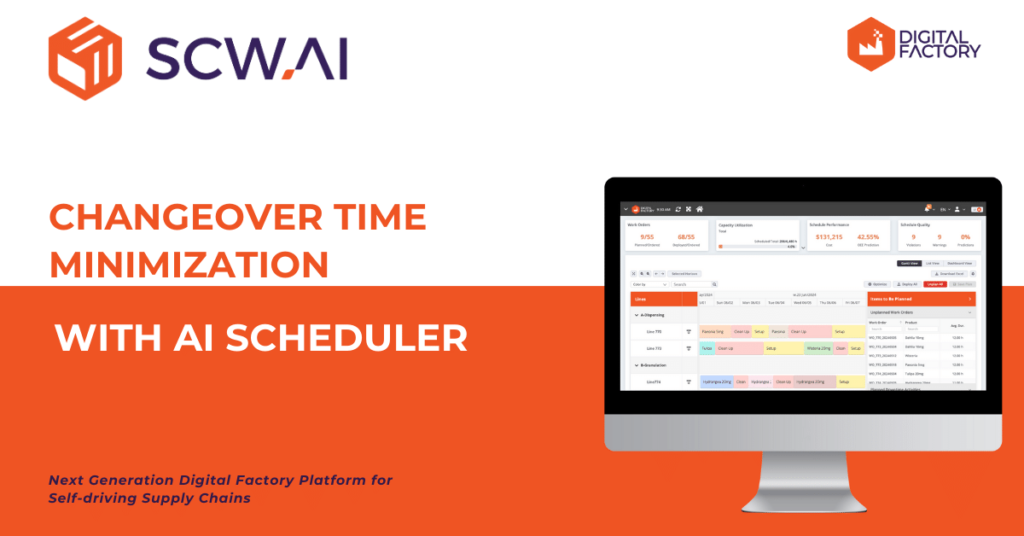Just in time scheduling is essential for many manufacturers, particularly those producing goods with short shelf lives. By aiming for optimal delivery time, just in time scheduling helps ensure that products are fresh and effective upon delivery. This is especially crucial for industries like food and beverage and radiopharmaceutical manufacturing.
However, as we will explore in this article, just in time scheduling and production come with their own challenges. Without the assistance of AI systems, creating an effective just in time schedule can be complicated. Moreover, the execution of the schedule must be flawless, as any deviation can significantly increase costs and damage a company’s reputation with customers.
This article will serve as manufacturers’ simplified guide to effectively managing just in time production. First, we will define just in time scheduling and provide a simplified, real-life example with its solution to assist readers to grasp the issue totally. Next, we will highlight the benefits and risks of just in time manufacturing and share best practices for executing your scheduling activities as planned. Finally, we will introduce our AI driven Scheduler, which can be instrumental in achieving your JIT scheduling goals.
An Introduction to the Concept of Just in Time
Just in time (JIT) is a specialized production approach in factories that aims to minimize the duration between receiving raw materials and delivering final products to end users. This strategy is particularly effective for companies seeking to reduce inventory costs. The concept of JIT is often associated with the Toyota Production System, which introduced JIT with the motto: “Produce only what is needed by customers, when it is needed, and as much as demand dictates.”
For automotive manufacturers like Toyota, JIT production is part of lean manufacturing, focusing on minimizing waste and movement. In some industries, JIT is crucial for quality of products rather than just cost reduction. For example, a food producer whose products lose freshness within a week cannot take the risk of holding inventory for long periods. Production must be timed precisely to match delivery schedules.
What is Just in Time Scheduling?
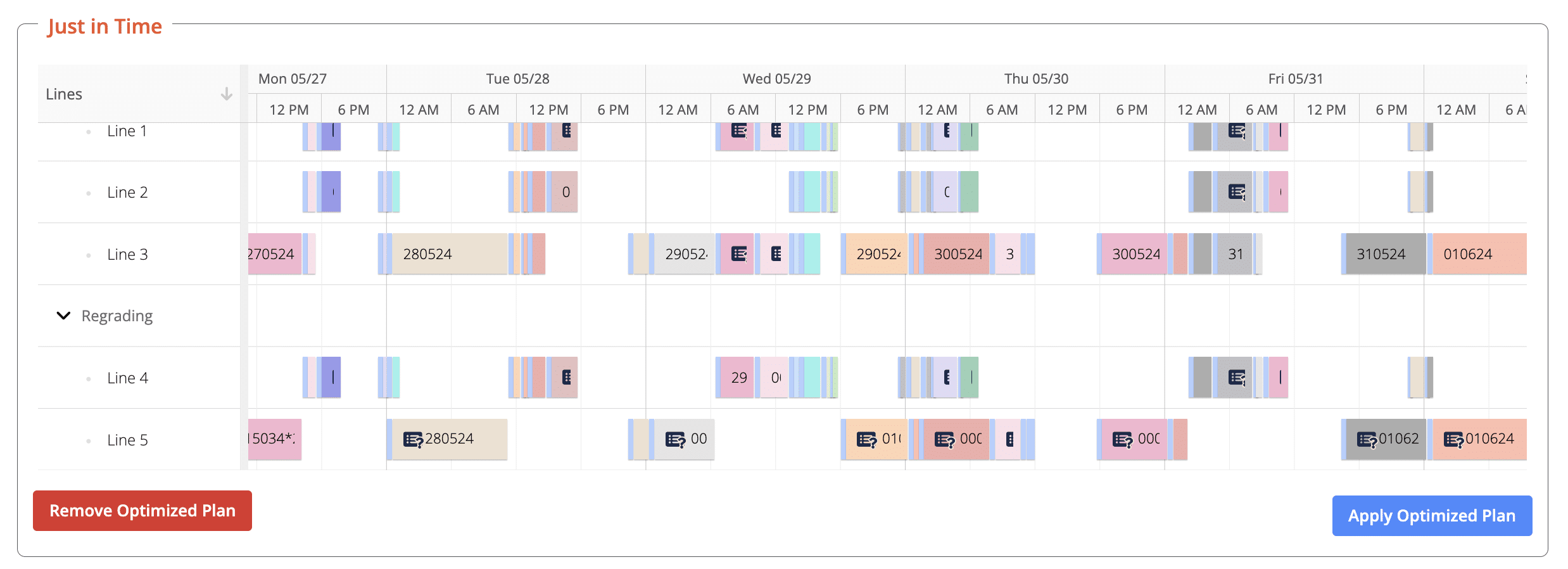
Just in time scheduling is a specialized approach to job shop scheduling in factories, aiming to minimize the duration between receiving raw materials and delivering final products to end users. The primary objectives for JIT scheduling are:
- Ensure each work order is completed by its due date.
- If multiple work orders have the same due date, prioritize those with shorter shelf lives (higher shelf life priority).
To achieve this, schedulers must first sort hundreds of work orders by due date, then by shelf-life priority. Given the constantly changing nature of customer demand, JIT professionals typically maintain short scheduling horizons. However, achieving JIT scheduling can be difficult and risky, especially in the absence of automated factory solutions.
JIT Scheduling Problem Example
The aim of this example is to explain JIT scheduling to manufacturers in a simplified manner. Imagine you are managing the production schedule for a small manufacturing company. You have six work orders to complete, each with a specific due date and priority based on shelf life. Your objective is to schedule these work orders in a way that ensures they are completed just in time for their due dates, prioritizing items with shorter shelf lives when multiple orders have coinciding due dates.
Here are the details of the work orders:
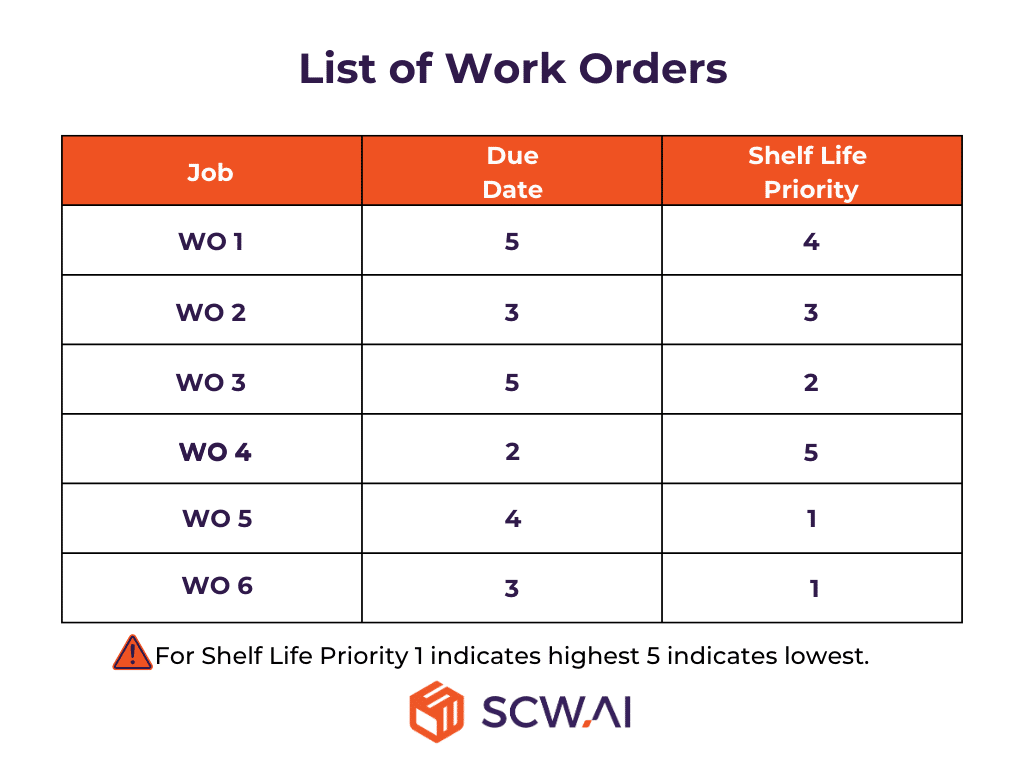
Step 1: Sort by Due Date in Ascending Order
First, we sort the work orders by their due dates in ascending order to find out which jobs should be prioritized.
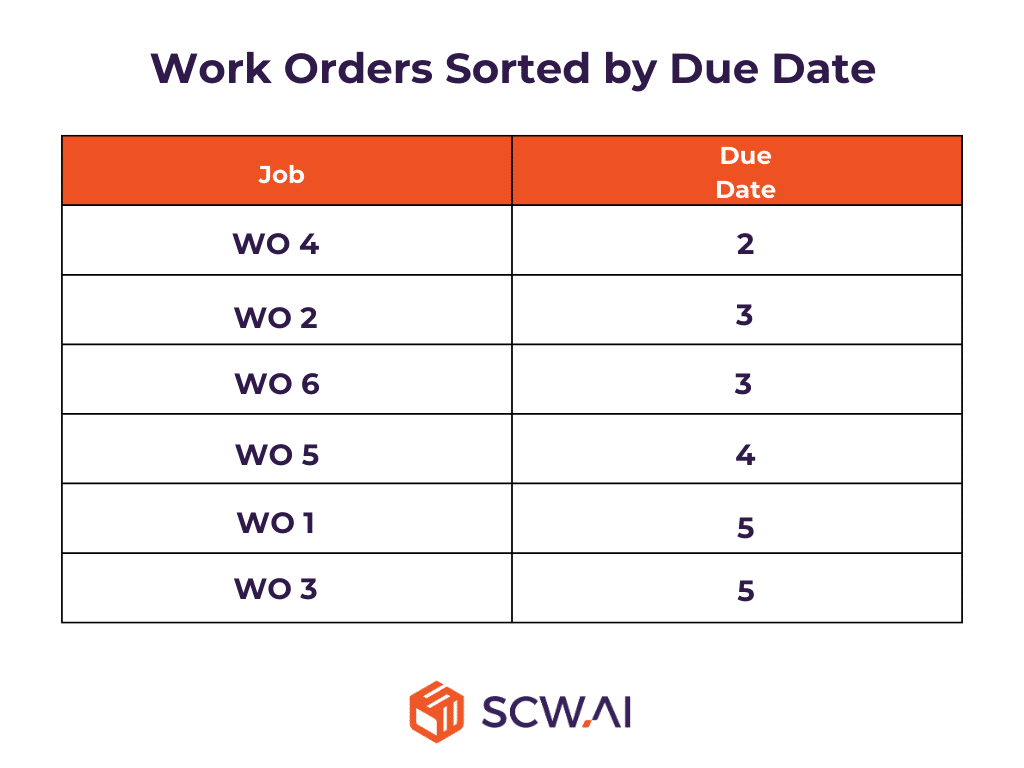
Step 2: Sort by Shelf Life Priority within Same Due Dates
The second step involves sorting work orders by their shelf-life priority. When due dates are identical, prioritize those with a shorter shelf life (designated by a higher number; 1 indicates the highest priority, 5 the lowest).
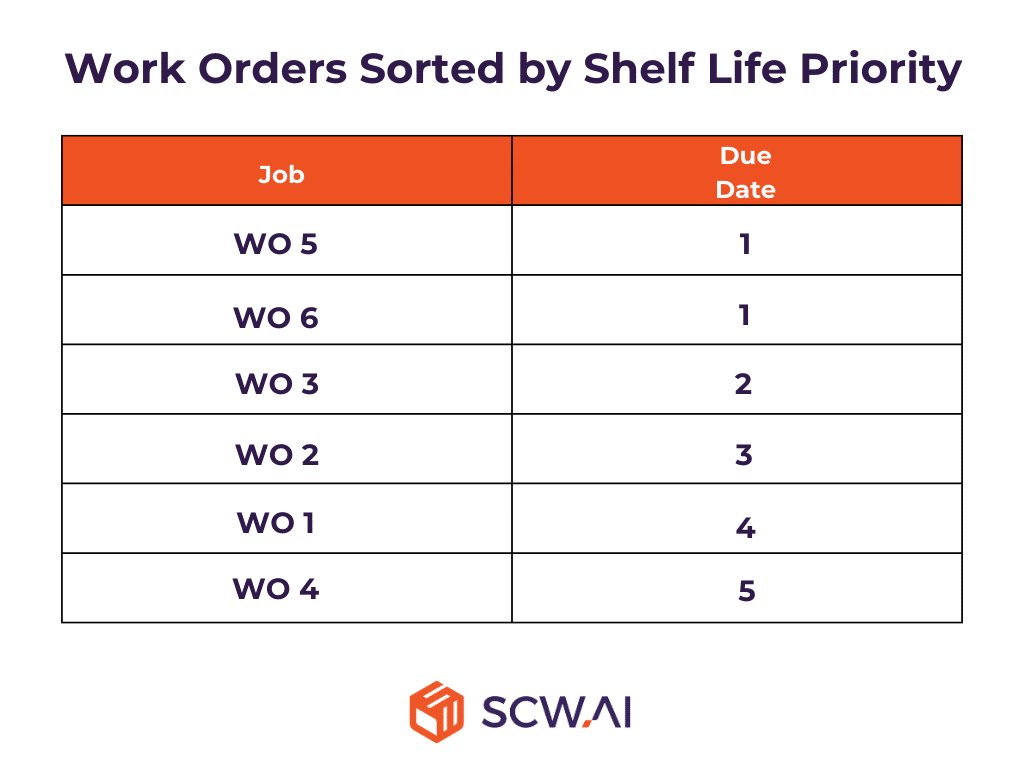
Step 3: Final Sorted List of Work Orders
Based on the sorted list, the work orders should be scheduled in the following order to meet the JIT delivery requirements:
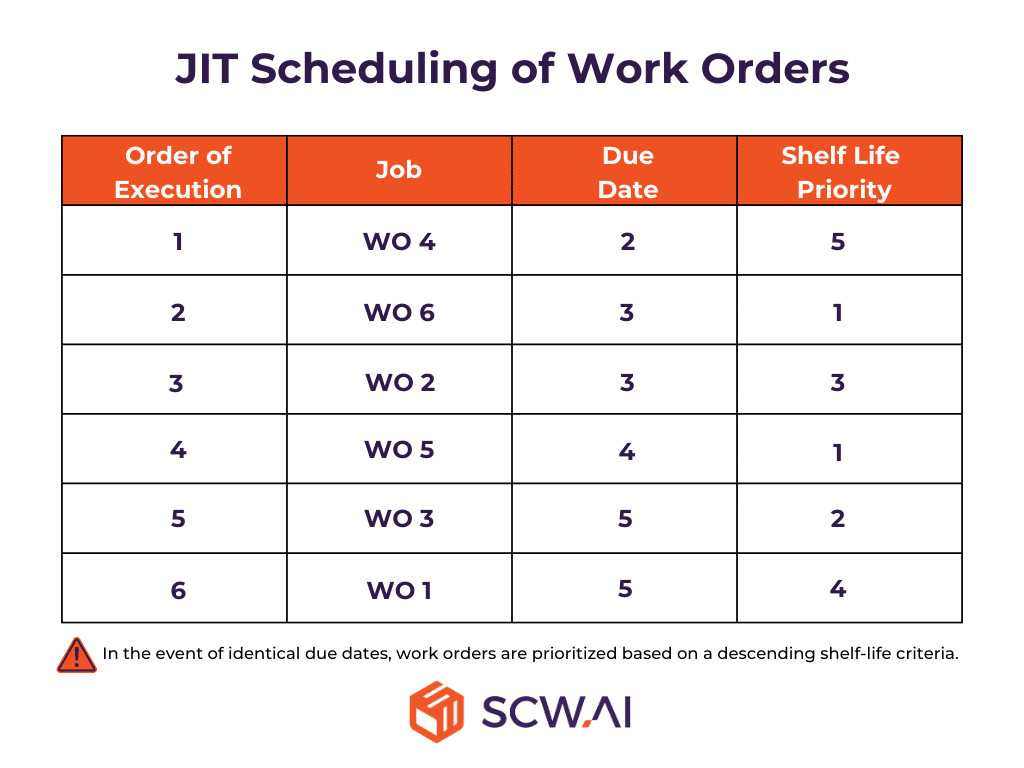
It is important to note that this example is oversimplified. In real-world scenarios, schedulers often deal with hundreds of work orders, each with varying production times and complexities. For instance, Work Order 5 might need to be produced first due to its short shelf life, especially if its production takes more than four days.
Additionally, we assume no differences in delivery destinations, which in reality add further complexity. Finally, we assume there are no unplanned downtimes or other external factors that could interrupt production. In short, ensuring JIT delivery in real life is a challenging task that requires schedulers to consider numerous factors.
AI’s Role in Just in Time Scheduling
Even in our simplified example with just six work orders, JIT scheduling is a time-consuming and error-prone task. For a regular factory with hundreds of work orders weekly, finding near-optimal JIT scheduling becomes a difficult endeavor. On the other hand, the higher computational power of AI models can solve JIT scheduling problems more quickly. Also AI models can consider additional factors and constraints and make schedules more realistic.
According to an analysis by the Boston Consulting Group, AI schedulers can reduce the time required to prepare schedules by half. Furthermore, analysis found that AI scheduling improves line balancing, allowing producers to approach their ideal takt time, which can be defined as the rate of production needed to complete work orders on time.
To find out more about other use cases of AI for shop floors you can read our Top 5 AI Use Cases in Manufacturing article.
Benefits of JIT
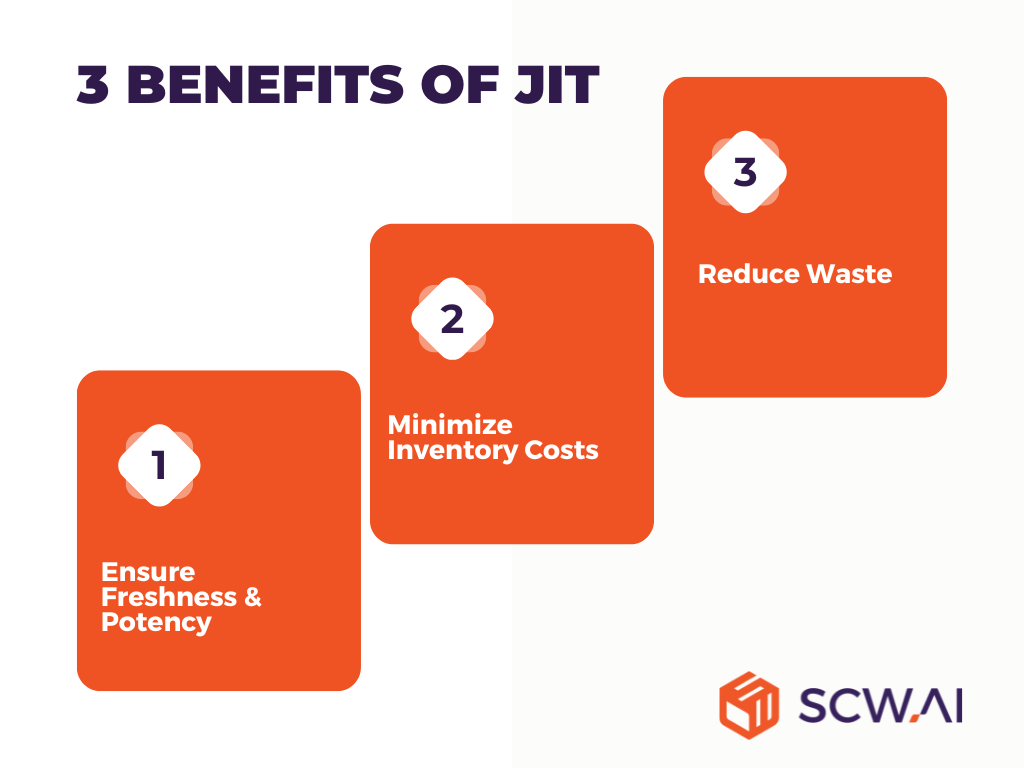
- Ensure Freshness and Potency: By producing or acquiring goods only as needed, businesses ensure that their products are as fresh as possible when they reach customers. This is particularly crucial for industries like food, pharmaceuticals, and cosmetics, where product freshness directly impacts quality and customer satisfaction.
- Minimize Inventory Costs: With JIT, companies can maintain lower inventory levels, reducing the need for large storage facilities and the expenses related to maintaining them. This cost efficiency translates into better overall profitability for the business.
- Reduce Waste: Since inventory is produced only when needed, there is less risk of overproduction, which can lead to excess inventory that may become obsolete or expire. This approach not only conserves resources but also aligns with sustainable business practices by reducing the environmental impact associated with waste disposal.
Which Industries Can Benefit From JIT Scheduling
Food and Beverage Industry
The food and beverage industry is one of the industries that can benefit significantly from just in time scheduling. By minimizing the time between production and delivery, JIT scheduling ensures that food products reach consumers at their peak freshness, enhancing taste and nutritional value. This approach reduces the need for extensive storage, lowering the risk of spoilage and waste.
Radiopharmaceuticals
Radiopharmaceuticals have extremely short half-lives, meaning they decay rapidly and lose their effectiveness within hours or days. By minimizing the time between production and delivery, JIT scheduling ensures that these critical medical products reach healthcare providers while they are still potent, maximizing their therapeutic efficacy. This approach also reduces the need for extensive storage and handling, minimizing the risk of exposure to radiation and ensuring compliance with strict regulatory standards.
In the video below, Indranil Nandi, Chief Scientific Officer at Jubilant Radiopharma, explains the necessity of just in time manufacturing for radiopharmaceuticals.
For pharmaceutical professionals that seek to modernize their facilities, we recommend to check our informative article, Pharma 4.0: A Guide for Pharma Executives to Modernize Their Factories.
Automotive
By producing parts and vehicles only as needed, automotive companies can minimize the costs associated with storing large inventories, including warehousing, insurance, and depreciation expenses. For these companies JIT scheduling can improve several manufacturing KPIs such as inventory turnover, lead time, waste reduction etc.
It is important to note that for other manufacturers, such as those in the textile, electronics, composite industries and so on, JIT scheduling can provide similar benefits. These industries can also see reduced inventory costs, improved production efficiency, and enhanced responsiveness to market demands.
Risk of JIT
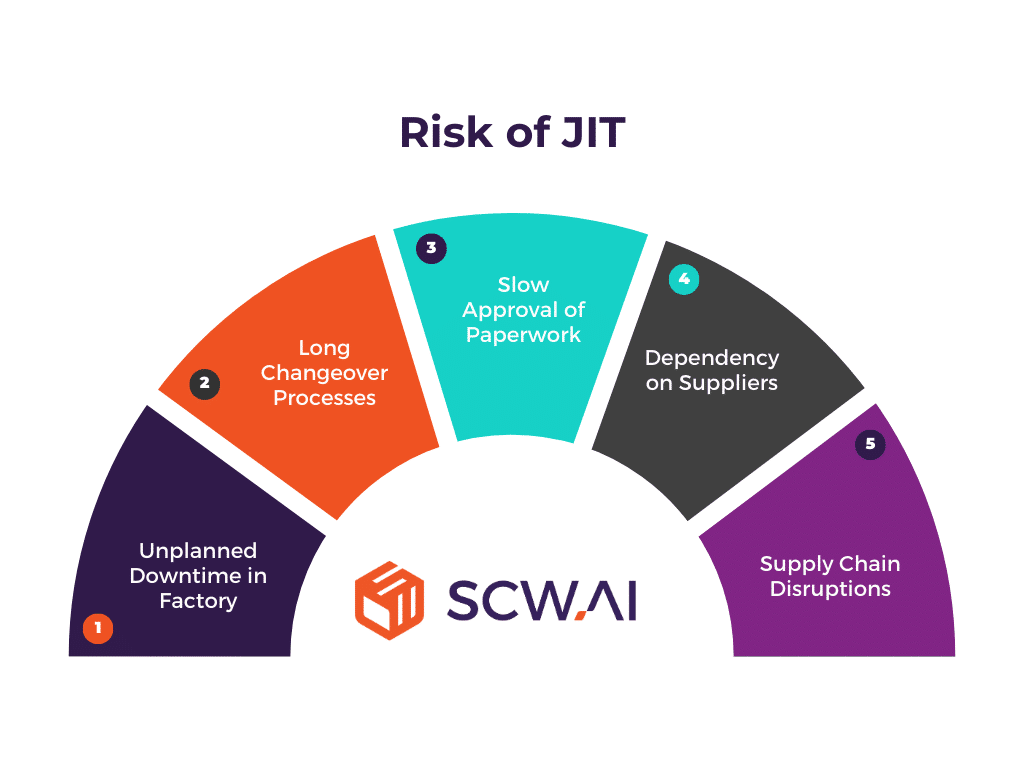
Anything that causes a deviation from JIT scheduling threatens JIT production and delivery. Even minor disruptions can have significant ripple effects, impacting the entire supply chain and production process.
- Unplanned Downtime in Factory: Unexpected equipment failures or maintenance issues can halt production, leading to delays and missed deadlines.
- Long Changeover Processes: Extended times required to switch from producing one product to another can disrupt the smooth flow of production.
- Slow Approval of Paperwork: Delays in the approval of necessary documentation, such as customs or regulatory paperwork, can slow down the receipt of materials and components. Additionally, approvals required from factory managers due to regulatory constraints can further impede the production process, affecting the entire JIT schedule.
- Dependency on Suppliers: JIT requires a high level of reliability from suppliers. Any failure on their part, whether due to financial instability, production issues, or logistical challenges, directly impacts the company’s ability to maintain a JIT production process.
- Supply Chain Disruptions: Events such as natural disasters, political instability, or transportation strikes can interrupt the supply of necessary materials, affecting production timelines.
5 Strategies to Manage Risk of JIT Scheduling
This section demonstrates the best practices that help manufacturers execute efficient JIT production by minimizing the risks mentioned in the previous section. As you can see from the image below, we have identified five business practices that manage the risk of just-in-time scheduling.
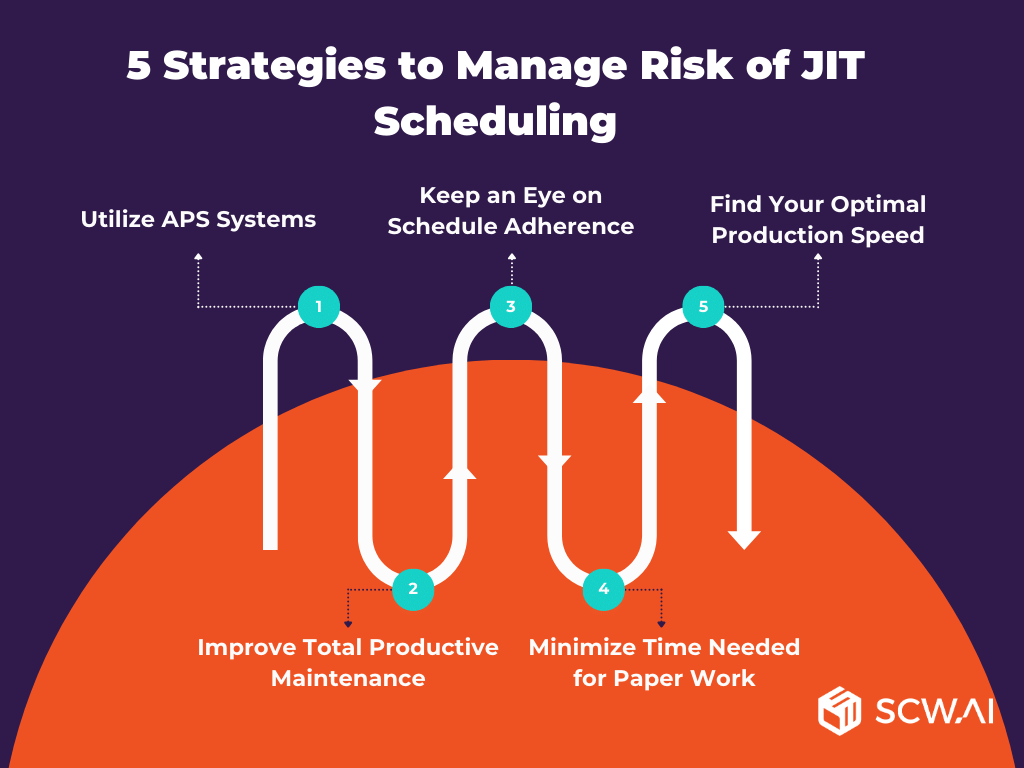
1. Utilize Advanced Planning and Scheduling Systems
Advanced Planning and Scheduling (APS) systems serve as invaluable tools for schedulers, offering user-friendly digital interfaces and real-time data to manage various aspects of JIT scheduling, such as:
- Monitoring the availability of raw materials
- Monitoring the availability of production lines
- Monitoring the availability of operators and line leaders
- Assessing production speed and capacity of each line and machine
- Tracking the quantity and due dates of each work order, and more.
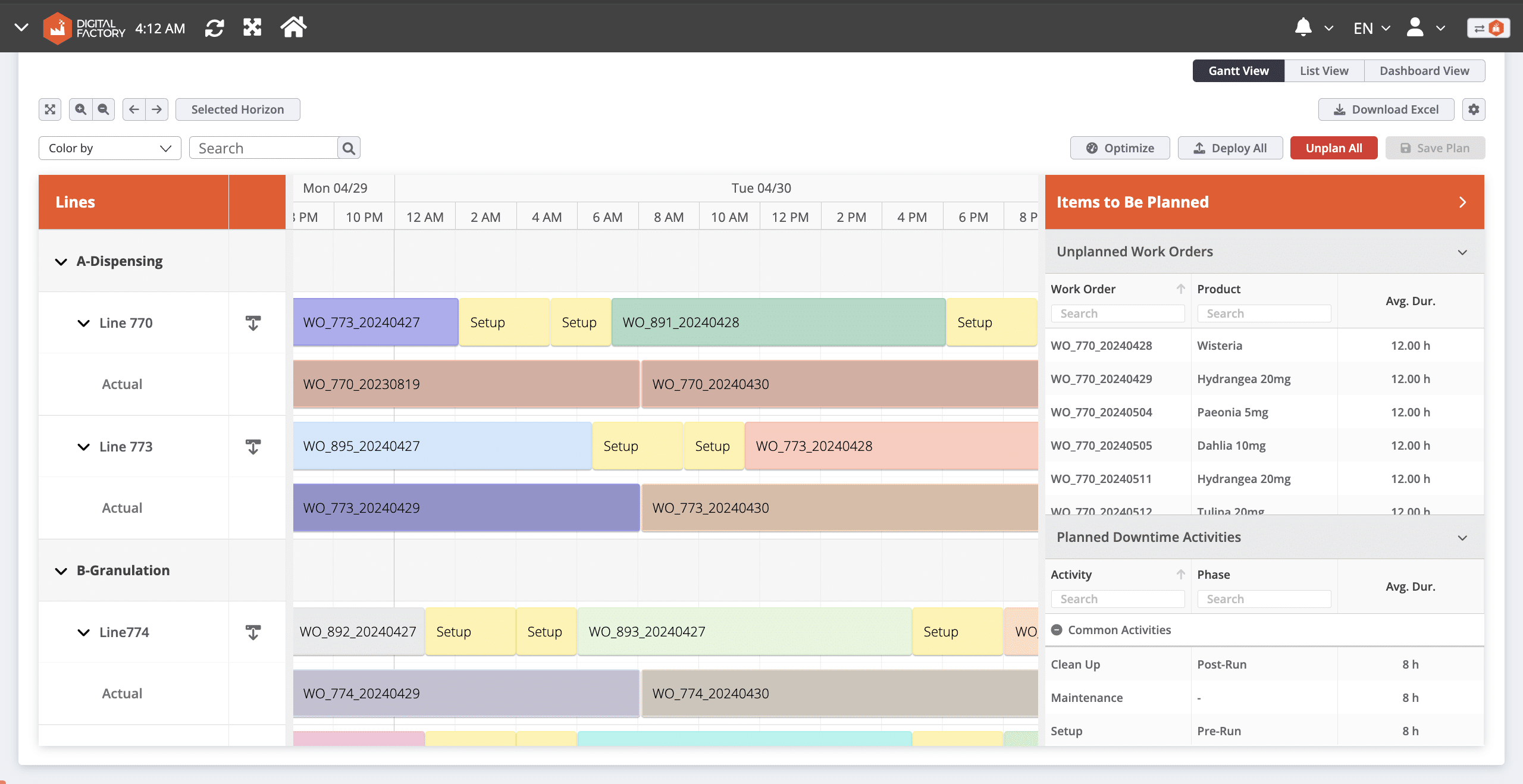
In addition to facilitating job shop scheduling and labor scheduling through easy to use digital interfaces, APS tools often incorporate AI capabilities. These capabilities enable APS systems to determine optimal production schedules tailored to different scheduling objectives, including just-in-time.
Consequently, we regard APS systems as essential investments for manufacturers aiming to manage their JIT schedules with precision.
2. Improve Total Productive Maintenance
Total Productive Maintenance (TPM) is a lean approach that aims to minimize machine failure-related unplanned downtime and maintenance costs by:
- Instilling a sense of responsibility among all shop floor personnel for the assets.
- Employing best practices such as 5S
- And integrating digital technologies to enhance proactive maintenance and production tracking.
One rationale behind TPM is the replacement of unplanned maintenance with planned maintenance activities. By proactively monitoring equipment, manufacturers can mitigate unplanned downtime and schedule downtime for maintenance tasks. This allows scheduling teams to more accurately estimate the productive time of machines and production lines, enabling the execution of more effective JIT schedules.
Moreover, digitalization can amplify the benefits of TPM. For example, instead of relying solely on predetermined maintenance schedules, manufacturers can harness machine learning-driven predictive maintenance models. By utilizing historical data on equipment health and inputs such as production speeds, ML tools can forecast machine failures with a high degree of precision (see the image below). Consequently, proactive maintenance can be conducted without significantly increasing planned downtime. For instance, according to a Deloitte analysis, predictive maintenance increases line availability by between 10% to 20%.

3. Keep an Eye on Schedule Adherence
As previously noted, any deviations in production can disrupt just-in-time scheduling. Consequently, monitoring KPIs such as schedule adherence and schedule compliance in real-time is crucial for manufacturers embracing a JIT mindset. These metrics reveal the percentage of planned and initiated work orders compared to all planned work orders, as well as the percentage of compliance between planned and actual production durations.
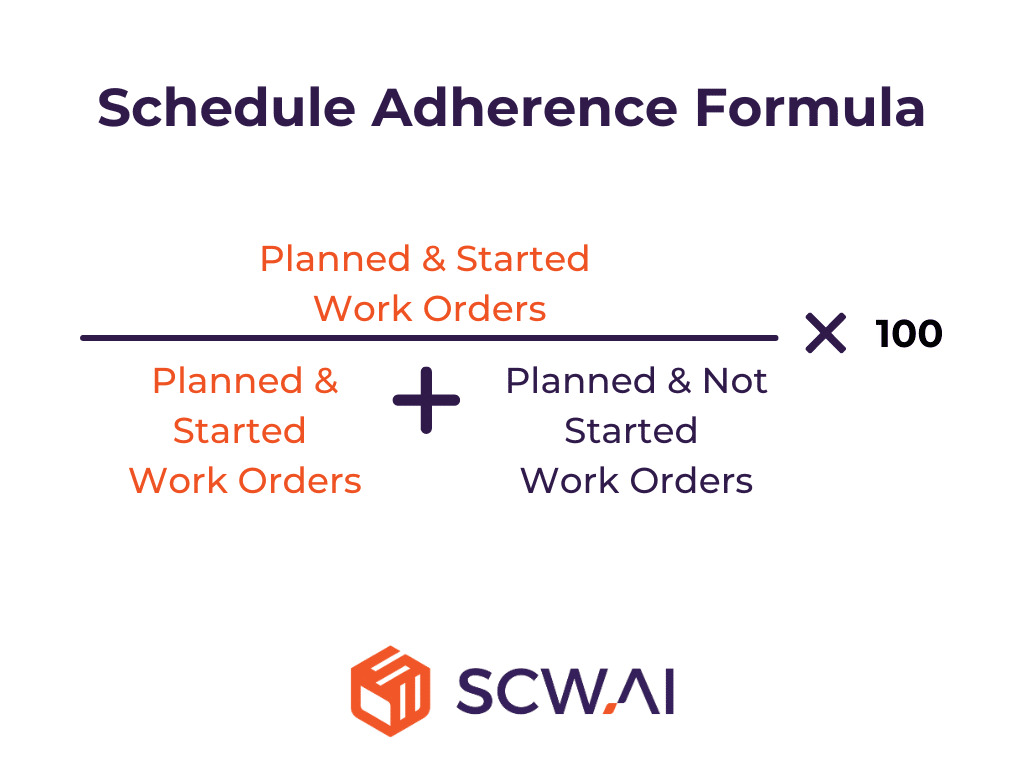

Given the importance of monitoring these metrics, we recommend that manufacturers utilize a Schedule Adherence Report. This report provides critical insights into the health of scheduling activities in real-time. Thus, in case of deviations manufacturers can take necessary actions before JIT production collapses.

Moreover, our Schedule Adherence Report provides granular data for each work order and its activities, such as cleanup, setup (with the summation of these giving the total changeover period), and run time, comparing planned and actual phase durations. By reviewing this report, managers can identify which work orders are behind schedule and determine which specific activities are causing delays. If bottlenecks exist, such as actual setup durations consistently taking longer than planned, targeted training programs can be initiated to address these issues.

In the era of Industry 4.0, training programs can be developed using generative AI. By uploading information about machine setup from documents and SOPs, generative AI can learn the intricacies of the setup process and create written documents, images, and videos to teach operators. Additionally, generative AI can prepare quizzes to assess the success of the training and provide further assistance to operators who receive unsatisfactory grades.
To learn more about how you can utilize generative AI in your factory read our In-Depth Guide to Generative AI in Manufacturing article.
4. Minimize Time Needed for Paper Work
Whether it concerns compliance or internal accountability, manufacturers document their activities. Often, they rely on paper-based documentation or Excel sheets for form entries. Unfortunately, these outdated methods neither provide real-time notifications for documents needing approval or completion nor offer a user-friendly interface that allows workers to check pending approvals with a single click.
Delays in paperwork, however, threaten the effectiveness of JIT scheduling. The impact of awaiting approvals is similar to that of unplanned downtime, as both render certain machines unavailable.
To address this issue, SCW.AI has designed a paperless manufacturing solution called Digital Logbook. With Digital Logbook, managers receive instant notifications about pending approvals. Its digital interface, smart form capabilities, and integration with other digital platforms reduce the time required for documentation activities by 50% to 80%, depending on the industry. Thus, staff can assign more time on production. Finally, our Digital Logbook is GMP compliant, ensuring ALCOA+ data integrity by design and improving compliance for food and beverage, cosmetic and pharmaceutical companies.
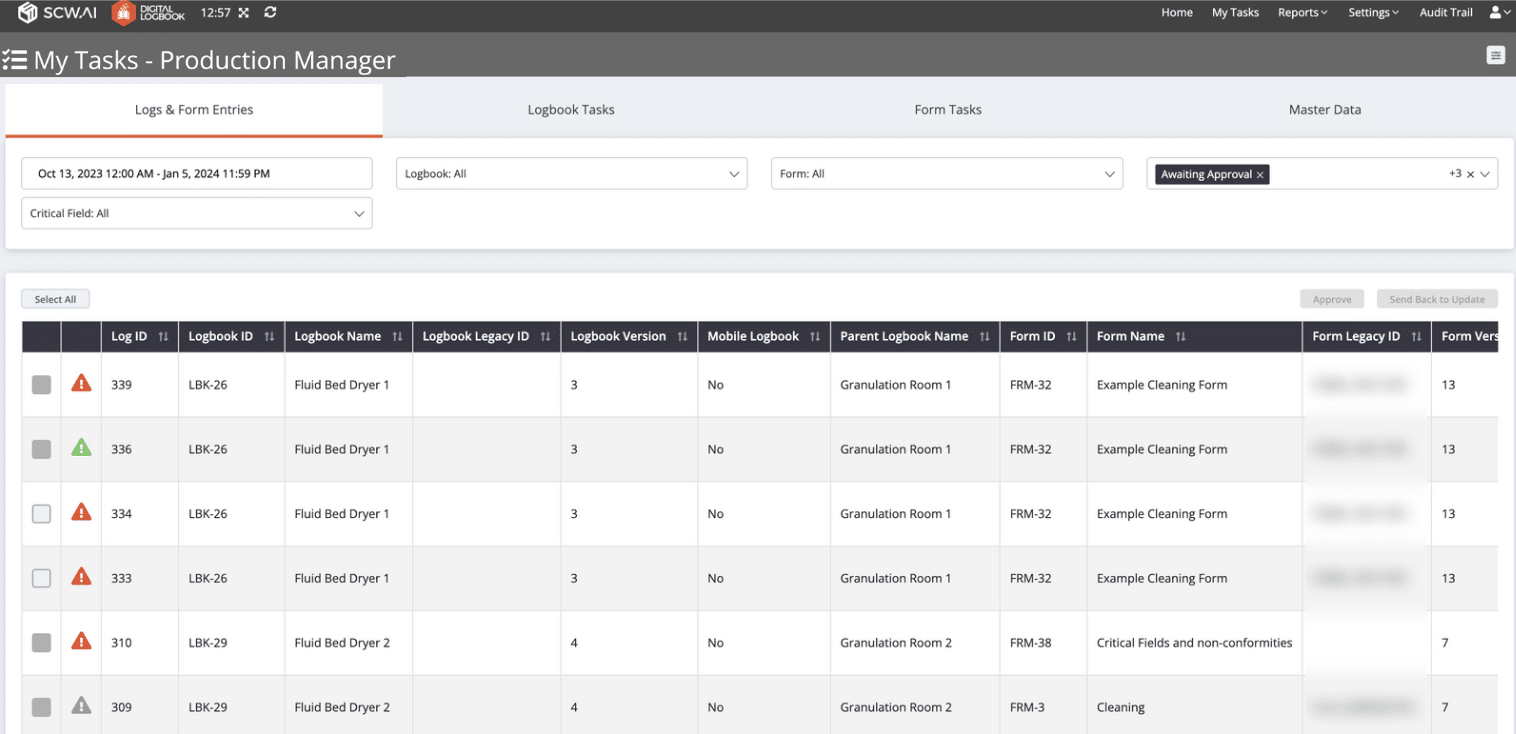
5. Find Your Optimal Production Speed
Leveraging the advanced simulation capabilities of digital twins, manufacturers can pinpoint the optimal production speed for each machine and production line. By creating a virtual replica of the production environment, digital twins allow for comprehensive analysis and testing of various operating conditions without disrupting the actual manufacturing process. Thus, manufacturers can find optimal production speed for each machine that not only maximizes output but also sustains the equipment’s lifespan by minimizing unplanned downtime and maintenance activities.
With these insights, manufacturers can fine-tune their JIT scheduling processes, achieving higher accuracy and efficiency. The ability to simulate different scenarios and predict outcomes means that production can be aligned more precisely with demand, and ensure timely delivery. This balance between optimal speed and equipment longevity contributes to more reliable and cost-effective manufacturing operations.
Discover SCW.AI’s Just in Time Scheduler and Digital Factory Platform
Our AI-driven APS system optimally solves job shop scheduling for various objectives, including JIT. Additionally, we help manufacturers effectively operate their JIT schedules with our cloud-driven manufacturing solution Digital Factory Platform, offering capabilities and reports such as:
- ML-driven predictive maintenance to reduce unplanned downtime.
- Schedule Adherence Reports providing real-time granular data on scheduling success.
- Digital Logbook to minimize time loss for documentation and approvals.
- Digital Twin technology to simulate and find optimal production batches.
To optimize your just in time schedules today, book a demo with us.

